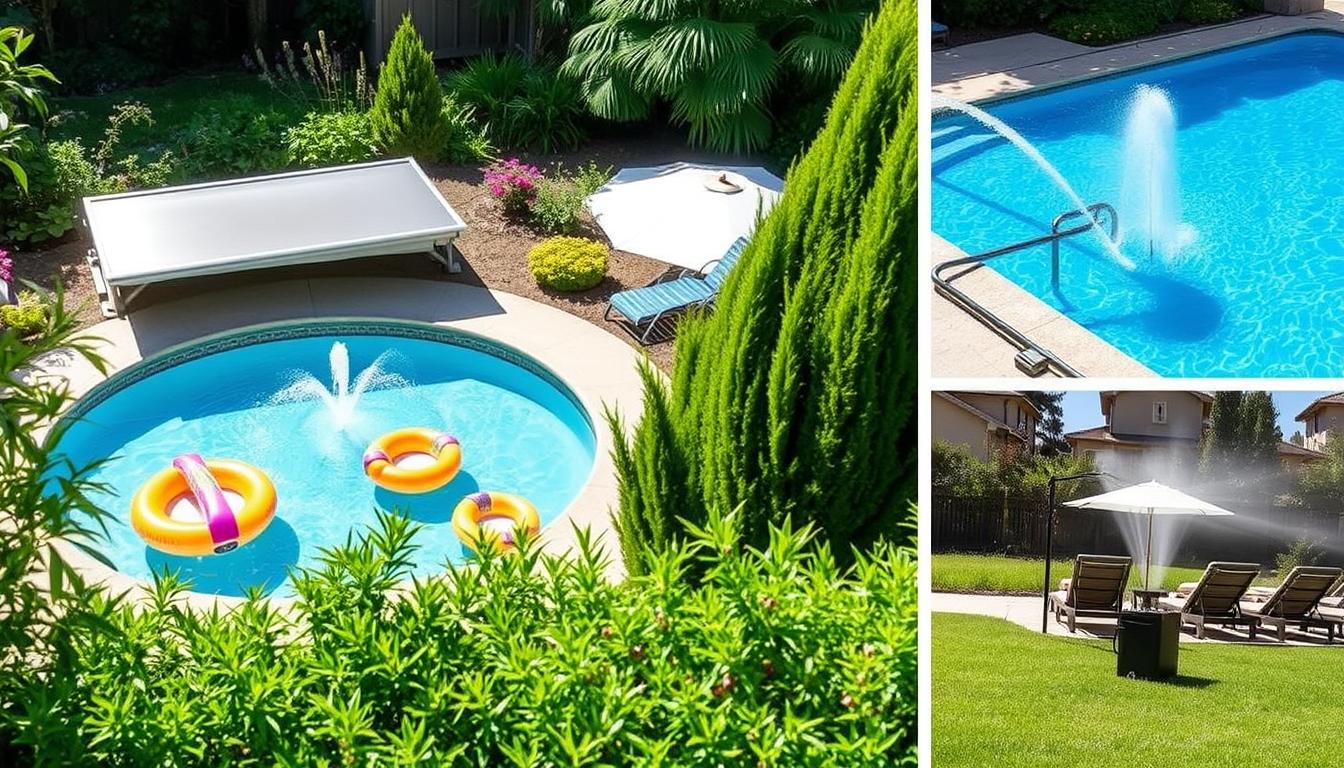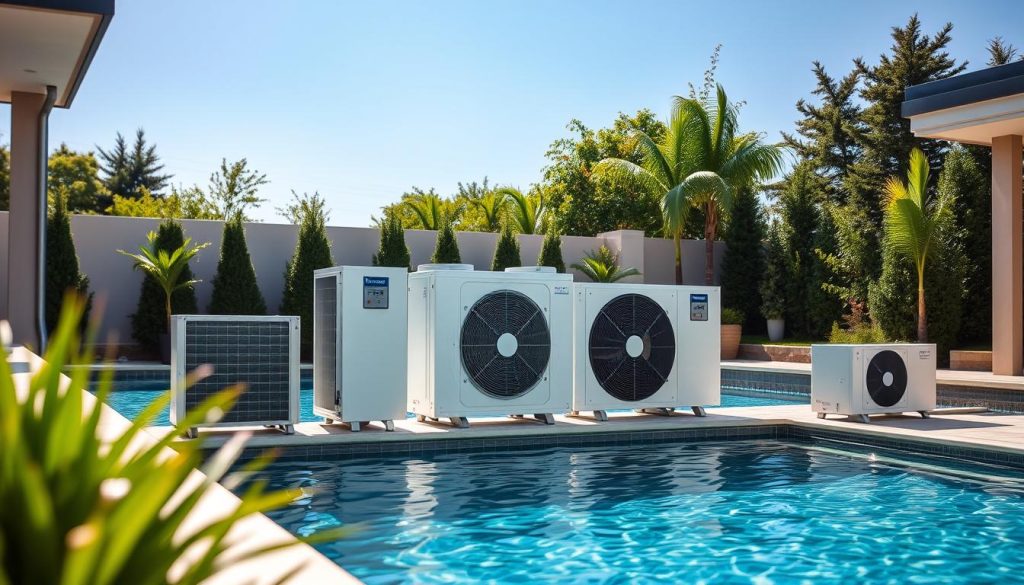
Summer heat can turn your backyard pool into lukewarm soup. This year, we’ve already seen eight days at 100 degrees or higher. Keeping pools cool has become crucial for many pool owners.
A comfortable pool temperature is vital for enjoyment and safety. The ideal range for swimming pools is 80-90 degrees. Anything outside this range can be uncomfortable.
Cooling a 20,000-gallon pool by 10 degrees would require 8,750 pounds of ice. That’s according to the Wall Street Journal.
There are several ways to combat summer heat and keep your pool refreshing. You can use aerators, water features, pool chillers, and heat pumps. These methods help reduce pool heat effectively.
Creating shade is another great strategy. Use umbrellas, pergolas, or natural tree cover. These can significantly help maintain cool pool water.
Don’t forget about water chemistry and landscaping. These factors are crucial in creating a cool, inviting pool atmosphere. By using these strategies, your pool can remain a refreshing oasis all summer long.
Aeration and Water Features for Pool Cooling
Pool aeration and water features offer effective, budget-friendly cooling solutions. Aerators spray water into the air, cooling it through evaporation. This process can lower pool temperature by a few degrees.
Water features like fountains and waterfalls enhance pool aesthetics. They also cool the water through evaporative cooling. These features expose more water surface to air, speeding up natural cooling.
Aeration boosts oxygen levels, helping prevent algae growth. It also raises pH, lowers alkalinity, and reduces calcium scaling. This means fewer chemicals and a better swimming experience.
Fountains and Waterfalls
Fountains and waterfalls cool pools through evaporative cooling. As water cascades, it releases heat into the air. Running these features at night is most effective due to cooler air temperatures.
Pools without built-in fountains can use aftermarket options. These easily attach to the pool return for added cooling benefits.
Bubblers and Jets
Pool bubblers and jets are another form of aeration. They create gentle air bubbles that rise to the surface. This promotes water circulation and mixing throughout the pool.
Bubblers and jets bring cooler water from the bottom up. This helps achieve a more uniform water temperature in the pool.
| Aeration Method | Cooling Effect | Additional Benefits |
|---|---|---|
| Aerators | Reduces water temperature by 2-3 degrees | Improves water circulation and quality |
| Fountains and Waterfalls | Cools water through evaporative cooling | Enhances pool aesthetics |
| Bubblers and Jets | Promotes uniform water temperature | Increases oxygen levels and deters algae growth |
Choosing an aeration method depends on pool size, climate, and desired cooling effect. Above-ground pools work well with compact aerators. Larger inground pools may need more powerful systems.
Hot climates require a focus on cooling capabilities. In humid areas, prioritize water quality and circulation for a healthier pool environment.
Pool Chillers and Heat Pumps
Pool chillers and heat pumps help control water temperature. These systems circulate pool water through cooling or heating processes. They ensure your pool stays comfortable for swimming.

Pool chillers lower water temperature using cooling systems. They come in air-cooled and water-cooled types. Water-cooled chillers are usually more efficient.
A pool without a chiller can reach 92°F in summer. With a chiller, the same pool stayed at 83°F. That’s a 9-degree difference.
Pool heat pumps can warm and cool water. They switch between modes easily. Heat pumps need a big investment upfront. They use lots of power but work well.
| System | Cost (Installed) | Cooling Effect |
|---|---|---|
| Pool Heat Pump | $4,000 – $6,500 | Heats and cools pool water |
| Pool Chiller | $600 – $1,000 (added to heat pump) | Reduces water temperature by several degrees |
| Combined System | $6,100 – $6,500 (total) | Provides comprehensive temperature control |
Heat pumps cost $4,000 to $6,500, including installation. Adding a chiller costs $600 to $1,000 more. The total investment is about $6,100 to $6,500.
Pools with automatic covers may need chillers. This is especially true where water can reach mid-90s. Adding a chiller to a heat pump isn’t too expensive.
Consider pool size, climate, and budget when choosing a cooling system. Installation and maintenance needs are also important. Talk to a pro to find the best solution for your pool.
Shade Solutions for Cooler Pools
Creating shade over your pool is a great way to keep it cool. Shade blocks sunlight, reducing solar heat absorption. A good shade structure can lower pool temperatures by 5-10°F (3-6°C).
Shade effectiveness depends on structure size, material type, climate, and sunlight intensity. UV-resistant materials are best at blocking solar radiation. Shade also helps reduce water evaporation, preserving water and temperature.
Pool umbrellas are portable and easy to adjust for targeted shade. Pergolas and canopies offer permanent structures that blend with your pool area. These options provide shade and enhance your outdoor space’s appeal.
Umbrellas, Pergolas, and Canopies
Pool umbrellas are portable and easy to set up. They can be adjusted throughout the day for targeted shade. Pergolas and canopies are permanent structures that fit your pool area’s style.
Natural Shade from Trees
Trees provide natural shade and cool the air through evapotranspiration. Choose trees based on mature size, growth rate, and leaf type. Deciduous trees offer summer shade and allow winter sunlight.
Effective pool shade creates a more comfortable swimming environment. It can lead to less frequent use of filtration and heating systems. This results in energy savings.
When choosing a shade structure, consider size, coverage, and material quality. Look for UV resistance and options for mobility and adjustability. This ensures optimal sun protection throughout the day.
Innovative Methods for How to Cool a Pool in the Summer
Some pool owners use unconventional cooling methods for quicker results. Adding ice directly to the pool can provide temporary relief. However, it’s impractical for regular use, requiring 8,750 pounds of ice for a 20,000-gallon pool.
Optimizing landscaping around the pool area promotes eco-friendly cooling. Clearing obstructions improves air circulation, allowing cooler air to pass over the water. This naturally decreases the pool’s temperature.
Pool solar panels can be used for nighttime cooling. Running water through the panels at night expels heat from the water. It’s important to avoid using solar covers, as they can trap heat.
A partial drain and refill with well water might be effective. Well water is cooler than surface water in summer. Consider water consumption and local regulations before using this method.
Combining these unconventional methods with traditional approaches can maintain a refreshing pool environment. This ensures an enjoyable swimming experience throughout the summer season.







